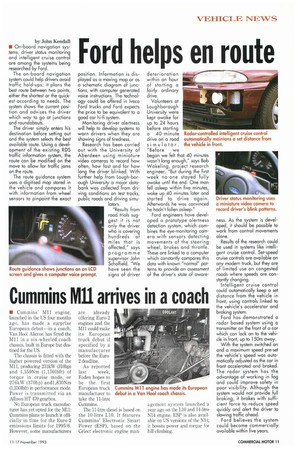Ford helps en route
Page 13

If you've noticed an error in this article please click here to report it so we can fix it.
by John Kendall • On-board navigation systems, driver status monitoring and intelligent cruise control are among the systems being researched by Ford.
The on-board navigation system could kelp drivers avoid traffic hold-ups: it plans the best route between two points, either the shortest or the quickest according to needs. The system shows the current position and advises the driver which way to go at junctions and roundabouts.
The driver simply enters his destination before setting out and the system selects the best available route. Using a development of the existing RD5 traffic information system, the route can be modified on the move to allow for traffic jams on the route.
The route guidance system uses a digitised map stored in the vehicle and compares it with information from wheel sensors to pinpoint the exact position. Information is displayed as a moving map or as a schematic diagram of junctions, with computer generated voice instructions. The technology could be offered in Iveco Ford trucks and Ford expects the price to be equivalent to a good car hi-fi system.
Monitoring driver alertness will help to develop systems to warn drivers when they are showing signs of tiredness. Research has been carried out with the University of Aberdeen using miniature video cameras to record how often, how fast and for how long the driver blinked. With further help from Lough-borough University a major databank was collected from driving conditions on test tracks, public roads and driving simulators.
"Results from road trials suggest it is not only the driver who is covering hundreds of miles that is affected," says programme supervisor John Scholfield. 'We have seen the signs of driver deterioration within an hour of starting a fairly ordinary drive.
Volunteers at Loughborough University were kept awake for up to 24 hours before starting a 40-minute drive on a road simulator.
"Before we began we felt that 40 minutes wasn't long enough," says Bob Wakeling, project research engineer. "But during the first week no-one stayed fully awake until the end. One man fell asleep within five minutes, woke up 40 minutes later and started to drive again. Afterwards he was convinced he hadn't fallen asleep."
Ford engineers have developed a prototype alertness detection system, which combines the eye-monitoring camera with sensors detecting movements of the steering wheel, brakes and throttle. These are linked to a computer which constantly compares this data with known "normal" patterns to provide an assessment of the driver's state of aware
ness. As the system is developed, it should be possible to work from control movements alone.
Results of the research could be used in systems like intelligent cruise control. Set-speed cruise controls are available on any modern truck, but they are of limited use on congested roads where speeds are constantly changing.
Intelligent cruise control could automatically keep a set distance from the vehicle in front, using controls linked to the vehicle's accelerator and braking. system. Ford has demonstrated a radar based system using a transmitter on the front of a car which can lock on to the vehicle in front, up to 150m away. With the system switched on and a maximum speed pre-set the vehicle's speed was automatically adjusted as the car in front accelerated and braked. The radar system has the advantage of working in fog and could improve safety in poor visibility. Although the system would not provide full braking, it brakes with sufficient force to reduce speed quickly and alert the driver to slowing traffic ahead. Ford believes the system could become commercially available within five years.




















































































